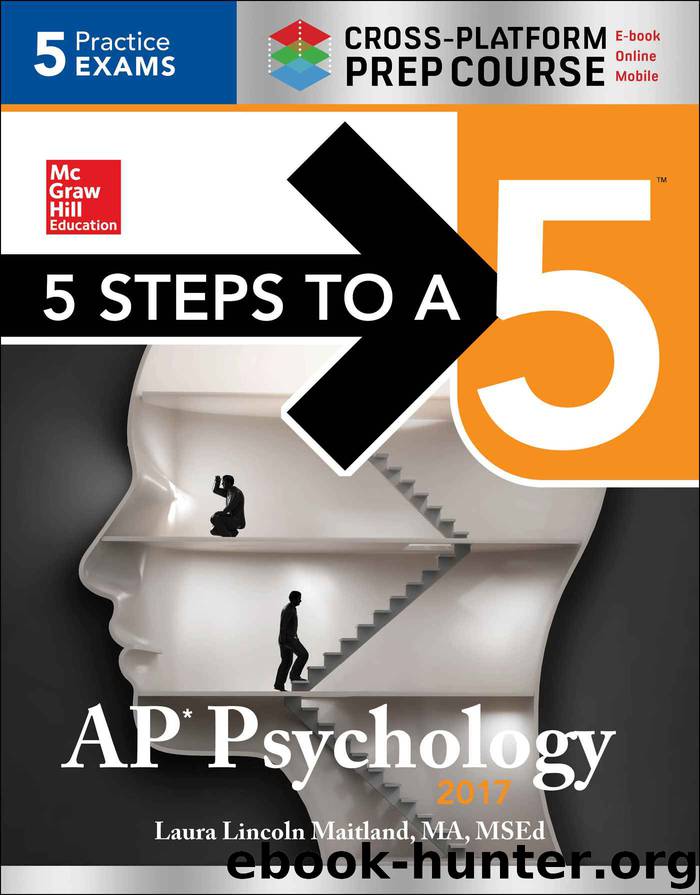5 Steps to a 5 AP Psychology 2017 Cross-Platform Prep Course by Maitland Laura Lincoln

Author:Maitland, Laura Lincoln [Maitland, Laura Lincoln]
Language: eng
Format: epub
Publisher: McGraw-Hill Education
Published: 2016-08-05T04:00:00+00:00
Answers and Explanations
1 . D— Securely attached kids tend to come to their mother for comfort when their mothers return. They are not necessarily clingy as choice C suggests.
2 . A— Nature refers to our heredity, and nurture refers to environmental factors.
3 . C— Longitudinal research. If an experimenter is interested in looking at the long-term effects of divorce on children like Mavis Hetherington did, follow-up visits and observations would be made periodically. The disadvantage of this research method is how costly it is to conduct these follow-up visits and how long it takes to analyze the results to reach conclusions.
4 . E— Object permanence occurs as a milestone in the sensorimotor stage when children can picture objects in their heads. When an experimenter hides a cookie behind a newspaper and the child uncovers it and says “cookie,” the child has achieved object permanence and is capable of representational thought.
5 . A— The rooting reflex can be seen when someone puts a finger on the baby’s cheek and the baby turns its head.
6 . B— Dorothy is experiencing the positive side of Erikson’s eighth stage of integrity. People like Dorothy tend to enjoy their golden years and continue to develop their interests.
7 . C— Conventional. Mr. Hernandez’s moral reasoning conforms with Kohlberg’s stage 4 “Law and Order” morality, which is a stage of the conventional level.
8 . A— Specific stimuli have a major effect on development that they do not produce at other times. Konrad Lorenz demonstrated the “critical period” for imprinting in goslings. Newly hatched babies first exposed to Lorenz followed him rather than their natural mothers if they had not been exposed to her soon after birth. Some theorists argue that mother–infant bonding and language development have critical periods.
9 . A— Both Piaget and Kohlberg stressed the importance of changes in thinking in their developmental stages. For example, both recognized that egocentric young children see the consequences of their actions from their own perspectives.
10 . A— Contact comfort. Harlow’s work with rhesus monkeys and surrogate mothers showed that even when food-deprived and anxious, monkeys preferred the terrycloth monkey to the wire monkey with food.
11 . B— The authoritative style of parenting is seen as the “best” style for nurturing independent, responsible, and socially competent teens and adults.
12 . D— Alcohol. The child’s mother likely drank alcohol throughout the pregnancy, producing the baby born with fetal alcohol syndrome. The effects of alcohol on prenatal brain development can be devastating.
13 . D— Both reinforcement and observing and imitating role models like parents contribute to the development of gender identity, according to some (behavioral) social learning theorists.
14 . B— Vygotsky’s sociocultural theory. Vygotsky advocated continuous cognitive growth. Vygotsky believed that with a mentor’s help, children can progress more rapidly through the same milestones they would achieve without a mentor’s help.
15 . D— Formal operational level. Kohlberg modeled his stages of moral development after Piaget’s stages of cognitive development. Those in Piaget’s formal operational stage have developed the ability to think abstractly
Download
This site does not store any files on its server. We only index and link to content provided by other sites. Please contact the content providers to delete copyright contents if any and email us, we'll remove relevant links or contents immediately.
Navigation and Map Reading by K Andrew(5111)
Spare by Prince Harry The Duke of Sussex(5074)
Tuesdays with Morrie by Mitch Albom(4694)
Cracking the GRE Premium Edition with 6 Practice Tests, 2015 (Graduate School Test Preparation) by Princeton Review(4227)
Machine Learning at Scale with H2O by Gregory Keys | David Whiting(4185)
Never by Ken Follett(3794)
Goodbye Paradise(3728)
What It Really Takes to Get Into Ivy League and Other Highly Selective Colleges by Hughes Chuck(3697)
Harry Potter and the Prisoner of Azkaban (Book 3) by J. K. Rowling(3304)
Fairy Tale by Stephen King(3220)
Pledged by Alexandra Robbins(3133)
Kick Ass in College: Highest Rated "How to Study in College" Book | 77 Ninja Study Skills Tips and Career Strategies | Motivational for College Students: A Guerrilla Guide to College Success by Fox Gunnar(3076)
A Dictionary of Sociology by Unknown(3031)
Sapiens and Homo Deus by Yuval Noah Harari(2987)
Reminders of Him: A Novel by Colleen Hoover(2952)
The Social Psychology of Inequality by Unknown(2941)
Graduate Admissions Essays, Fourth Edition: Write Your Way into the Graduate School of Your Choice (Graduate Admissions Essays: Write Your Way Into the) by Asher Donald(2876)
Will by Will Smith(2794)
Zero to Make by David Lang(2726)
